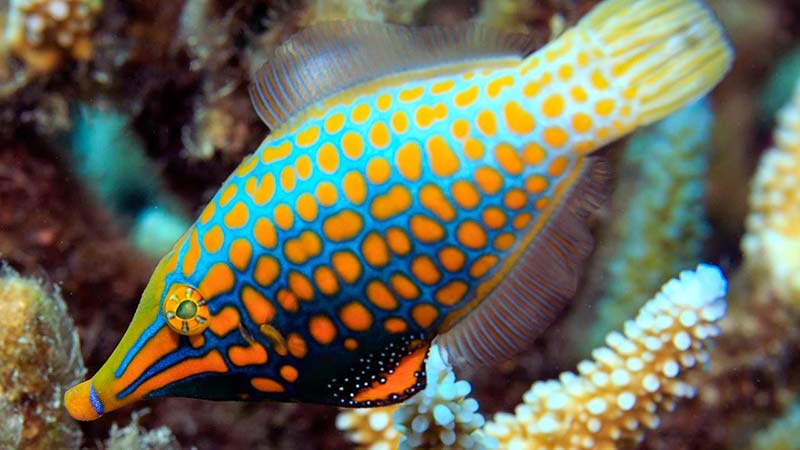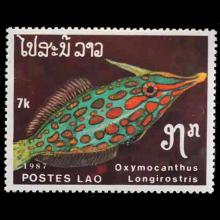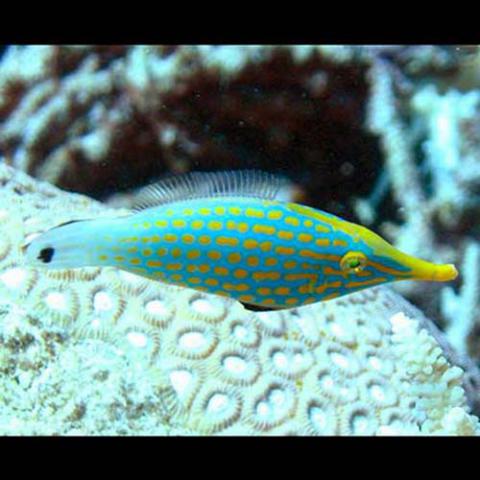NAMES
TAXONOMY
Laos
Issued:
Stamp:
Oxymonacanthus longirostris
Laos
Issued:
Stamp:
Oxymonacanthus longirostris
Laos
Issued:
Stamp:
Oxymonacanthus longirostris

Filefish uses 'smell camouflage' to hide from predators
By Kate Wheeling - Dec. 9, 2014, 7:15 PM
The harlequin filefish is a master of disguise. The reef-dwelling fish (Oxymonacanthus longirostris) sports a brightly colored pattern that allows it to fade into the coral it calls home. Now, scientists have discovered that the filefish doesn’t just look like a branch of coral—it smells like one, too. The researchers report online today in the Proceedings of the Royal Society B that the animal picks up the smell of the corals it feeds on, which serves as a handy disguise from the cunning predators that use odor to hunt down their prey. To identify this chemical camouflage, the team placed cod—a common predator of reef fish—in tanks with filefish and a species of coral that either matched their diet or a coral species the fish hadn’t been feeding on. The filefish were hidden inside perforated containers within the aquarium so that the cod could only smell, and not see, their prey. The researchers found that cod were much less likely to hang out around the filefish container when the species of coral present matched the reef fish’s last meals. Exactly how the filefish retains the coral smell is still unknown, but the disguise even fooled coral-feeding crabs. When the researchers gave the crabs a choice between their favorite corals and a filefish that fed on their favorite corals, they often chose the filefish. Many invertebrate species, like caterpillars, are known to incorporate compounds from the plants they eat into the outer layer of their skin to hide from hungry predators. But the filefish is the first vertebrate species found to camouflage its smell, which means that the behavior could be even more widespread across the animal kingdom than previously thought.
Genus species (Animalia): Oxymonacanthus longirostris
The orange spotted filefish or harlequin filefish, Oxymonacanthus longirostris, is a filefish in the family Monacanthidae found on coral reefs in the Indo-Pacific Oceans. The orangespotted filefish is a different species and refers to Cantherhines pullus.
The orange spotted filefish is pale blue with about eight longitudinal rows of orange-yellow patches. In the wild it feeds almost exclusively on Acropora polyps.
In the aquarium
They are often offered for sale in the aquarium trade, but few survive long in captivity. They are difficult to maintain in an aquarium unless provided with live corals. They must be kept in species-specific tanks, or tanks with very passive tankmates such as seahorses or pipefish. They have been successfully bred in captivity.
In the wild
Orange spotted filefish absorb and use chemicals in the Acropora coral they eat to take on its smell, which cloaks them from natural predators like cod. In addition to this trait, not observed among other vertebrates, they also use visual camouflage.
Life cycle and mating behavior
Aggression is used commonly in courtship. Spawning commences when after swimming together in different tufts, the female concentrates on just one and begins to thrust repeatedly and pause. The male follows suit nuzzling the female. The female then drops into the algae and spawns, while the male releases the sperm beside her. The pair then swims back to their territory. Monogamous mating is observed as both facultative and social.


